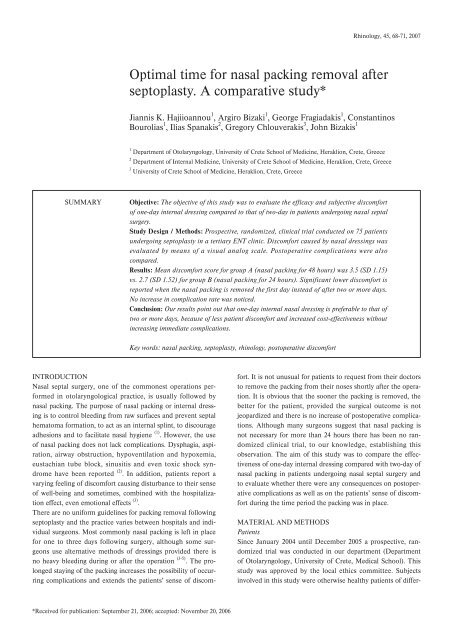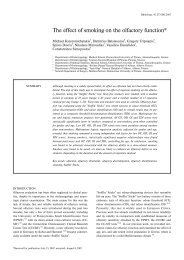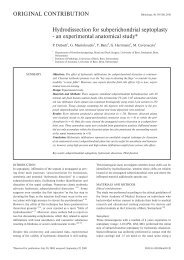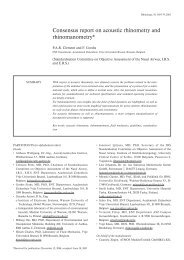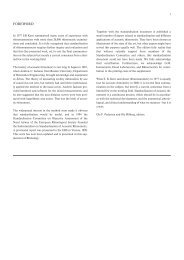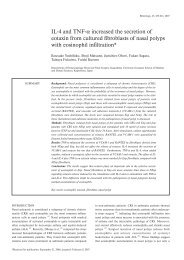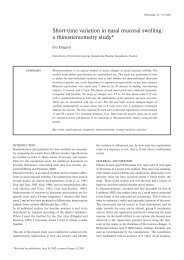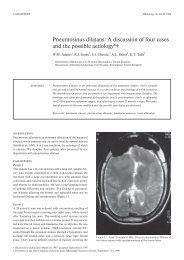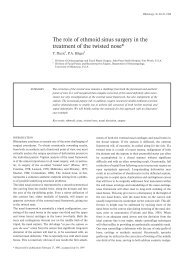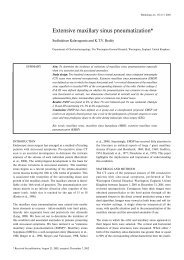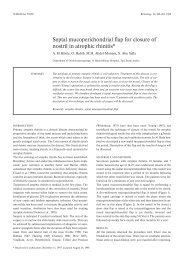Optimal time for nasal packing removal after septoplasty - Rhinology ...
Optimal time for nasal packing removal after septoplasty - Rhinology ...
Optimal time for nasal packing removal after septoplasty - Rhinology ...
You also want an ePaper? Increase the reach of your titles
YUMPU automatically turns print PDFs into web optimized ePapers that Google loves.
<strong>Rhinology</strong>, 45, 68-71, 2007<br />
<strong>Optimal</strong> <strong>time</strong> <strong>for</strong> <strong>nasal</strong> <strong>packing</strong> <strong>removal</strong> <strong>after</strong><br />
<strong>septoplasty</strong>. A comparative study*<br />
Jiannis K. Hajiioannou 1 , Argiro Bizaki 1 , George Fragiadakis 1 , Constantinos<br />
Bourolias 1 , Ilias Spanakis 2 , Gregory Chlouverakis 3 , John Bizakis 1<br />
1 Department of Otolaryngology, University of Crete School of Medicine, Heraklion, Crete, Greece<br />
2 Department of Internal Medicine, University of Crete School of Medicine, Heraklion, Crete, Greece<br />
3 University of Crete School of Medicine, Heraklion, Crete, Greece<br />
SUMMARY<br />
Objective: The objective of this study was to evaluate the efficacy and subjective discom<strong>for</strong>t<br />
of one-day internal dressing compared to that of two-day in patients undergoing <strong>nasal</strong> septal<br />
surgery.<br />
Study Design / Methods: Prospective, randomized, clinical trial conducted on 75 patients<br />
undergoing <strong>septoplasty</strong> in a tertiary ENT clinic. Discom<strong>for</strong>t caused by <strong>nasal</strong> dressings was<br />
evaluated by means of a visual analog scale. Postoperative complications were also<br />
compared.<br />
Results: Mean discom<strong>for</strong>t score <strong>for</strong> group A (<strong>nasal</strong> <strong>packing</strong> <strong>for</strong> 48 hours) was 3.5 (SD 1.15)<br />
vs. 2.7 (SD 1.52) <strong>for</strong> group B (<strong>nasal</strong> <strong>packing</strong> <strong>for</strong> 24 hours). Significant lower discom<strong>for</strong>t is<br />
reported when the <strong>nasal</strong> <strong>packing</strong> is removed the first day instead of <strong>after</strong> two or more days.<br />
No increase in complication rate was noticed.<br />
Conclusion: Our results point out that one-day internal <strong>nasal</strong> dressing is preferable to that of<br />
two or more days, because of less patient discom<strong>for</strong>t and increased cost-effectiveness without<br />
increasing immediate complications.<br />
Key words: <strong>nasal</strong> <strong>packing</strong>, <strong>septoplasty</strong>, rhinology, postoperative discom<strong>for</strong>t<br />
INTRODUCTION<br />
Nasal septal surgery, one of the commonest operations per<strong>for</strong>med<br />
in otolaryngological practice, is usually followed by<br />
<strong>nasal</strong> <strong>packing</strong>. The purpose of <strong>nasal</strong> <strong>packing</strong> or internal dressing<br />
is to control bleeding from raw surfaces and prevent septal<br />
hematoma <strong>for</strong>mation, to act as an internal splint, to discourage<br />
adhesions and to facilitate <strong>nasal</strong> hygiene (1) . However, the use<br />
of <strong>nasal</strong> <strong>packing</strong> does not lack complications. Dysphagia, aspiration,<br />
airway obstruction, hypoventilation and hypoxemia,<br />
eustachian tube block, sinusitis and even toxic shock syndrome<br />
have been reported (2) . In addition, patients report a<br />
varying feeling of discom<strong>for</strong>t causing disturbance to their sense<br />
of well-being and some<strong>time</strong>s, combined with the hospitalization<br />
effect, even emotional effects (3) .<br />
There are no uni<strong>for</strong>m guidelines <strong>for</strong> <strong>packing</strong> <strong>removal</strong> following<br />
<strong>septoplasty</strong> and the practice varies between hospitals and individual<br />
surgeons. Most commonly <strong>nasal</strong> <strong>packing</strong> is left in place<br />
<strong>for</strong> one to three days following surgery, although some surgeons<br />
use alternative methods of dressings provided there is<br />
no heavy bleeding during or <strong>after</strong> the operation (3-5) . The prolonged<br />
staying of the <strong>packing</strong> increases the possibility of occurring<br />
complications and extends the patients’ sense of discom<strong>for</strong>t.<br />
It is not unusual <strong>for</strong> patients to request from their doctors<br />
to remove the <strong>packing</strong> from their noses shortly <strong>after</strong> the operation.<br />
It is obvious that the sooner the <strong>packing</strong> is removed, the<br />
better <strong>for</strong> the patient, provided the surgical outcome is not<br />
jeopardized and there is no increase of postoperative complications.<br />
Although many surgeons suggest that <strong>nasal</strong> <strong>packing</strong> is<br />
not necessary <strong>for</strong> more than 24 hours there has been no randomized<br />
clinical trial, to our knowledge, establishing this<br />
observation. The aim of this study was to compare the effectiveness<br />
of one-day internal dressing compared with two-day of<br />
<strong>nasal</strong> <strong>packing</strong> in patients undergoing <strong>nasal</strong> septal surgery and<br />
to evaluate whether there were any consequences on postoperative<br />
complications as well as on the patients’ sense of discom<strong>for</strong>t<br />
during the <strong>time</strong> period the <strong>packing</strong> was in place.<br />
MATERIAL AND METHODS<br />
Patients<br />
Since January 2004 until December 2005 a prospective, randomized<br />
trial was conducted in our department (Department<br />
of Otolaryngology, University of Crete, Medical School). This<br />
study was approved by the local ethics committee. Subjects<br />
involved in this study were otherwise healthy patients of differ-<br />
*Received <strong>for</strong> publication: September 21, 2006; accepted: November 20, 2006
Nasal <strong>packing</strong> <strong>removal</strong> <strong>after</strong> <strong>septoplasty</strong> 69<br />
ent ages undergoing <strong>septoplasty</strong> <strong>for</strong> deviation of the <strong>nasal</strong> septum.<br />
Patients that were under psychic energizers, hypnotic and<br />
antidepressant medication were excluded from this study.<br />
Patients with additional rhinologic problems besides <strong>nasal</strong> septum<br />
deviation (upper and lower <strong>nasal</strong> cartilage de<strong>for</strong>mities,<br />
<strong>nasal</strong> bone de<strong>for</strong>mities, inferior turbinate hypertrophy, <strong>nasal</strong><br />
polyps) were not included in this study.<br />
Operation<br />
The subjects were randomly assigned in two groups: group A,<br />
where the <strong>nasal</strong> <strong>packing</strong> remained <strong>for</strong> 48 hours and group B,<br />
where the <strong>nasal</strong> <strong>packing</strong> remained <strong>for</strong> 24 hours. The patients<br />
were not in<strong>for</strong>med <strong>for</strong> the duration of the <strong>packing</strong> because it<br />
might have affected their discom<strong>for</strong>t scores. All patients were<br />
operated under general anaesthesia by the two senior surgeons<br />
(J.B., J.H.) using the same technique. Preoperatively endo<strong>nasal</strong><br />
topical vasoconstriction was applied using gauges impregnated<br />
in xylomatazoline 0,1%. Local vascular hemostasis was applied<br />
to all patients by injection of 2 ml lidocaine HCl 1% with epinephrine<br />
1: 100000 at the caudal end of the septum into the<br />
<strong>nasal</strong> base. Our technique briefly consisted of hemitransfixion<br />
incision, creation of septal tunnels, posterior chondrotomy,<br />
osteotomies if necessary, septal reposition and reconstruction.<br />
Septal cartilage in the collumelar pocket was fixated by interrupted<br />
vicryl (3-0) sutures. Packing was applied by placing<br />
three loosely woven gauges impregnated with Vaseline and<br />
antibiotics (fucidinic acid) that are commercially available. All<br />
patients were discharged <strong>after</strong> package <strong>removal</strong> <strong>for</strong> the fear of<br />
accidental dislocation of the package to the nasopharynx. All<br />
patients were treated postoperatively with antibiotics <strong>for</strong> three<br />
days.<br />
Postoperative evaluation<br />
Postoperatively the patients were asked to evaluate their sense<br />
of discom<strong>for</strong>t attributed to <strong>nasal</strong> <strong>packing</strong> on a visual analog<br />
scale (range 1-10) in specific <strong>time</strong> points (12 hours, 24 hours,<br />
36 hours, 48 hours postoperatively). No pain medication was<br />
administered unless it was requested by the patients.<br />
Following <strong>packing</strong> <strong>removal</strong>, patients were examined <strong>for</strong> complications<br />
like nose bleeding or septal hematoma <strong>for</strong>mation.<br />
The patients were also evaluated <strong>for</strong> fever, which could imply<br />
possible infection (fever was considered a temperature rise<br />
over 38 ˚C).<br />
Prior to commencing the study, a power analysis was per<strong>for</strong>med<br />
to determine the sample size needed to detect with<br />
high probability a prespecified difference in the sense of discom<strong>for</strong>t<br />
when <strong>nasal</strong> <strong>packing</strong> was applied <strong>for</strong> different <strong>time</strong><br />
periods. More precisely, power calculations showed that a total<br />
of at least 70 patients are needed to achieve 80% power to<br />
detect a treatment difference at a two-sided 5% significance<br />
level, assuming the true difference in discom<strong>for</strong>t between the<br />
two treatments is 1 and that the standard deviation is 1.5.<br />
The data derived from the visual analog scale were subjected<br />
to the Mann-Whitney non parametric test. In order to compare<br />
<strong>for</strong> postoperative complications crosstabs procedure with<br />
Fischer’s exact test was used.<br />
RESULTS<br />
Our series included 70 patients, 39 male and 31 female<br />
between ages 21 and 55 (mean age 33; Table 1). For group A,<br />
(35 patients), where <strong>nasal</strong> <strong>packing</strong> remained <strong>for</strong> 48 hours, the<br />
mean discom<strong>for</strong>t score at 12 hours was 3.8 (SD 2.26), at 24<br />
hours 2.7 (SD 1.52), at 36 hours 3.5 (SD 1.33) and at 48 hours<br />
3.5 (SD 1.15). For group B, (35 patients) where <strong>nasal</strong> <strong>packing</strong><br />
remained <strong>for</strong> 24 hours, the mean discom<strong>for</strong>t score at 12 hours<br />
was 3.4 (SD 1.91) and at 24 hours 2.44 (SD 2.71) (Table 2,<br />
Figure 1). Significantly lower discom<strong>for</strong>t was noticed between<br />
24 hours and 36 hours (p < 0.05 Mann-Whitney test) and<br />
between 24 hours and 48 hours (p < 0.01 Mann-Whitney test).<br />
No significantly lower discom<strong>for</strong>t scores were noticed between<br />
36 and 48 hours. Moreover, significantly higher discom<strong>for</strong>t<br />
Table 1. Baseline clinical and demographic parameters.<br />
<strong>nasal</strong> <strong>packing</strong><br />
Group A 48 hours Group B 24 hours<br />
Mean Count Mean Count<br />
age 33,34 33,57<br />
gender male 20 19<br />
female 15 16<br />
scores were reported at 12 hours compared to 24 hours<br />
(p < 0.01 Mann-Whitney test).<br />
Bleeding <strong>after</strong> <strong>nasal</strong> <strong>packing</strong> <strong>removal</strong> was noticed in 9 patients<br />
(4 in group A and 5 in group B). In all cases it was minor epistaxis,<br />
lasting <strong>for</strong> few minutes without necessity of reinsertion<br />
of <strong>nasal</strong> <strong>packing</strong>. No cases of septal hematoma occurred. Fever<br />
was noticed in 7 patients (6 in group A 1 in group B). Pain<br />
medication was used in 44 patients (20 patients in group A and<br />
22 in group B). Marginal significance was noticed on postoperative<br />
fever between the study groups. In group A, where <strong>nasal</strong><br />
<strong>packing</strong> remained <strong>for</strong> 48 hours, 6 patients presented with fever<br />
greater than 38˚C versus 1 patient in group B (p = 0,053<br />
Fischer’s exact test). No significant differences were revealed<br />
on postoperative bleeding, or pain medication used (Fischer’s<br />
exact test) (Table 3).<br />
Table 2. Mean discom<strong>for</strong>t scores reported by the patients in specific<br />
<strong>time</strong> points <strong>after</strong> the <strong>nasal</strong> <strong>packing</strong> placement.<br />
<strong>nasal</strong> <strong>packing</strong><br />
Discom<strong>for</strong>t Group A 48 hours Group B 24 hours<br />
Mean SD Mean sD<br />
12 hours 3,84 2,26 3,4 1,91<br />
24 hours 2,71 1,52 2,44 2,71<br />
36 hours 3,53 1,53<br />
48 hours 3,45 1,15
70 Hajiioannou et al.<br />
Table 3. Postoperative complications that were noticed in both groups.<br />
Postoperative<br />
complications<br />
Group A<br />
48 hours<br />
<strong>nasal</strong> <strong>packing</strong><br />
Group B<br />
24 hours<br />
Fischer’s<br />
Exact Test<br />
bleeding <strong>after</strong> <strong>removal</strong> 4 5 0,5<br />
of <strong>packing</strong><br />
Fever > 38 6 1 0,053<br />
Use of pain medication 21 23 0,4<br />
DISCUSSION<br />
Nasal <strong>packing</strong> or internal <strong>nasal</strong> dressing is considered routine<br />
by most doctors at the completion of <strong>nasal</strong> septal surgery.<br />
Some rhinologists prefer the term “internal <strong>nasal</strong> dressing”<br />
when gauges are applied endo<strong>nasal</strong>ly to adjust the repositioned<br />
<strong>nasal</strong> structures and keep them in new position and the term<br />
“<strong>nasal</strong> <strong>packing</strong>” when gauges are more or less <strong>for</strong>cefully<br />
brought into the <strong>nasal</strong> cavity to stop <strong>nasal</strong> bleeding (6) . In our<br />
study we used the terms “<strong>nasal</strong> <strong>packing</strong>” and “internal <strong>nasal</strong><br />
dressing” with the same meaning. The <strong>packing</strong> is intended to<br />
prevent postoperative swelling and hematoma <strong>for</strong>mation.<br />
Many types of <strong>nasal</strong> <strong>packing</strong> are used and the number of days<br />
that it is used varies greatly in the literature (7) . Huizing<br />
believes that it is not the material that counts but the care with<br />
which these internal dressings are applied (6) . Yet, there are no<br />
established guidelines regarding the period of <strong>time</strong> that <strong>packing</strong><br />
should remain. In our study we looked into the effect of<br />
<strong>nasal</strong> <strong>packing</strong> on patients undergoing <strong>septoplasty</strong> by measuring<br />
the resulting discom<strong>for</strong>t in specific <strong>time</strong> points following operation<br />
completion using VAS questionnaires. We also tried to<br />
find out if earlier <strong>removal</strong> of the <strong>nasal</strong> <strong>packing</strong> increases the<br />
complication rate and risks the outcome of the operation.<br />
As it has already been reported by many authors <strong>nasal</strong> <strong>packing</strong><br />
is not an innocuous process (8) . The pitfalls of <strong>packing</strong> comprise<br />
increased patient discom<strong>for</strong>t, rinorrhea, increased postoperative<br />
swelling and edema, bleeding upon <strong>packing</strong> <strong>removal</strong>,<br />
mucosal lesions and the risk of infection inherent to the presence<br />
of a <strong>for</strong>eign body with the rare complicating of toxic<br />
shock syndrome. A serious complication consists of the disturbance<br />
of breathing during sleep or decrease in nocturnal arterial<br />
PO 2 . In some studies, <strong>nasal</strong> <strong>packing</strong> has been associated with<br />
stroke, myocardial infarction, and sudden death possibly due<br />
to nocturnal changes in oxygen saturation (9) . Other complications<br />
include dislocation of the <strong>nasal</strong> dressings with possible<br />
aspiration, eustachian tube dysfunction, allergy, paraffin granulomas<br />
and spherulocytosis (9,10) .<br />
In our department all patients undergoing <strong>septoplasty</strong> are not<br />
allowed to return home with <strong>nasal</strong> <strong>packing</strong> inside. Prolonged<br />
<strong>nasal</strong> <strong>packing</strong> leads to prolonged hospitalization resulting in<br />
higher insurance costs and lost workdays. It may cause sleep<br />
disturbances and possibly an undesirable emotional effect in<br />
patients who wish to return home soon.<br />
While the highest noticed discom<strong>for</strong>t was <strong>after</strong> 12 hours of<br />
<strong>nasal</strong> <strong>packing</strong>, probably due to absorption of <strong>nasal</strong> fluids and<br />
blood, our study showed significant increase in patients discom<strong>for</strong>t<br />
when <strong>packing</strong> remained endo<strong>nasal</strong>ly more than 24<br />
hours. The prolonged hospitalization might contribute to this<br />
effect. In fact, many of our patients usually request the<br />
<strong>removal</strong> of endo<strong>nasal</strong> dressings as soon as possible while many<br />
surgeons routinely remove the <strong>nasal</strong> <strong>packing</strong> <strong>after</strong> 24 hours (11)<br />
and some others do not use <strong>packing</strong> at all (3-5) .<br />
The comparison between groups A and B did not display any<br />
significant differences in immediate complication rate concerning<br />
hemorrhage or headache. Minor epistaxis following<br />
<strong>removal</strong> of <strong>nasal</strong> <strong>packing</strong> and headache were almost equal in<br />
number <strong>for</strong> both groups. A marginal significance was noticed<br />
regarding fever that was higher in more patients in the 48-hour<br />
<strong>nasal</strong> <strong>packing</strong> group. However, a greater sample would be necessary<br />
in order to draw safer conclusions regarding the immediate<br />
complications and a longer follow-up period is needed<br />
<strong>for</strong> evaluating late complications such as synechiae or deviation<br />
of the septum from the midline.<br />
Based on our findings, we support the use of one-day internal<br />
<strong>nasal</strong> dressing instead of two or more days since less discom<strong>for</strong>t<br />
is caused to the patients and less hospitalization <strong>time</strong> is<br />
required. In this way, one-day internal <strong>nasal</strong> dressing is more<br />
cost effective without further increasing immediate complication<br />
rate as bleeding or hematomas.<br />
Figure 1. Box plots presetting the discom<strong>for</strong>t distribution in both<br />
groups. Cases 17 and 22 are outliers.<br />
REFERENCES<br />
1. Salassa JR, Pearson BW. Polyethylene oxide gel. A new intra<strong>nasal</strong><br />
dressing <strong>after</strong> septorhinoplasty. Arch Otolaryngol Head Neck Surg.<br />
1991; 117: 1365-1367.<br />
2. Watson MG, Campbell JB, Shenoi PM. Nasal surgery: Does the<br />
type of <strong>nasal</strong> pack influence the results? <strong>Rhinology</strong> 1989; 27: 105-<br />
111.
Nasal <strong>packing</strong> <strong>removal</strong> <strong>after</strong> <strong>septoplasty</strong> 71<br />
3. Muluk NB, Oguzturk O, Ekici A, Koc C. Emotional effects of<br />
<strong>nasal</strong> <strong>packing</strong> measured by the Hospital Anxiety and Depression<br />
Scale in patients following <strong>nasal</strong> surgery. J Otolaryngol. 2005; 34:<br />
172-177.<br />
4. Hogg RP, Prior MJ, Johnson AP. Admission rates, early readmission<br />
rates and patient acceptability of 142 cases of day case <strong>septoplasty</strong>.<br />
Clin Otolaryngol Allied Sci. 1999; 24: 213-215.<br />
5. Reiter D, Al<strong>for</strong>d E, Jabourian Z. Alternatives to <strong>packing</strong> in septorhinoplasty.<br />
Arch Otolaryngol Head Neck Surg. 1989; 115: 1203-<br />
1205.<br />
6. Huizing EH, de Groot JAM. Functional Reconstructive Nasal<br />
Surgery Stuttgart – New York : Thieme 2003.<br />
7. Illum P, Grymer L, Hilberg O. Nasal <strong>packing</strong> <strong>after</strong> <strong>septoplasty</strong>.<br />
Clin Otolaryngol Allied Sci. 1992; 17: 158-162.<br />
8. Wagner R, Toback JM. Toxic shock syndrome following <strong>septoplasty</strong><br />
using plastic septal splints.Laryngoscope. 1986; 96: 609-610.<br />
9. Taasan V, Wynne JW, Cassisi N, Block AJ. The effect of <strong>nasal</strong><br />
<strong>packing</strong> on sleep-disordered breathing and nocturnal oxygen<br />
desaturation. Laryngoscope. 1981; 91: 1163-1172.<br />
10. Weber R, Hochapfel F, Draf W. Packing and stents in endo<strong>nasal</strong><br />
surgery. <strong>Rhinology</strong>. 2000; 38: 49-62.<br />
11. Hytonen M, Blomgren K, Lilja M, Makitie AA. How we do it: septoplasties<br />
under local anaesthetic are suitable <strong>for</strong> short stay<br />
surgery; the clinical outcomes.Clin Otolaryngol. 2006; 31: 64-68.<br />
John G. Bizakis MD<br />
Assoc. Professor of Otolaryngology<br />
University Hospital of Heraklion<br />
MAIL BOX 1352<br />
71500 Heraklion, Crete<br />
Greece<br />
Tel: 302810392347<br />
Fax: 2810542106<br />
E- mail: johnbizakis@yahoo.gr


